【Suika Game】How to make watermelon and tips to earn over 3000 points.<英語版>
【この記事にはPRを含む場合があります】
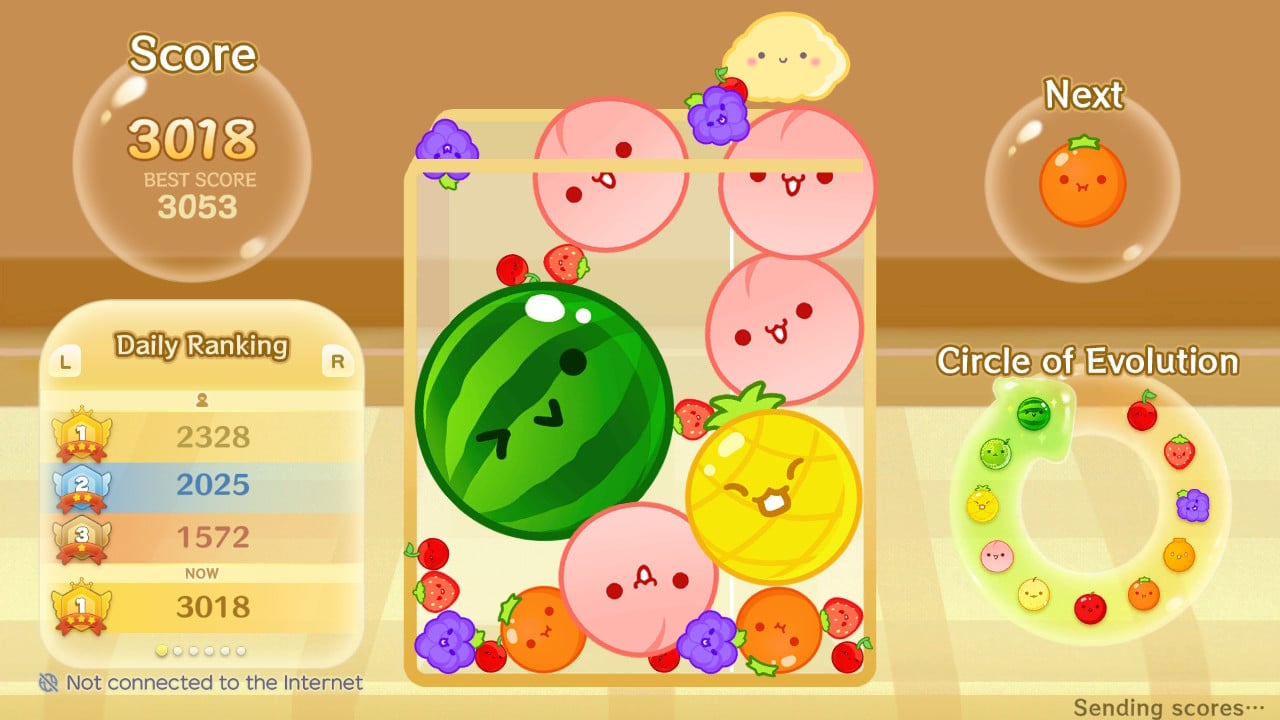
The ‘Suika game‘ (watermelon game) has gained worldwide popularity. Many players find it challenging to create watermelons and score over 3,000 points in the game.
In this issue, we will share tips from Japan on how to make watermelons in the game, a topic that has become widely discussed in Japan, along with strategies to achieve a score of over 3,000 points.

- How to make a watermelon in Suika Game?
- 1. Understand the 'frequency' of appearance of fruits
- 2. Early stage of the game: line up 'horizontally' with 'evolutionary order' in mind
- 3. After the second tier: do not place large fruit on top of small fruit
- 4. Put small fruits on the 'edge'
- 5. Don't wait too long to finish moving
- What is the strategy for over 3000 points?
- 1. Make the watermelon in an 'out of the way' position
- 2. Make sure the slope is gentle, not steep
- 3. Don't make larger fruits 'unnecessarily sparse'
- Luck is also important in Suika Game! Let's have fun by playing more times!
How to make a watermelon in Suika Game?
The first goal in playing ‘Suika game‘ (watermelon game) is to make watermelons.
The following are five tips for making watermelons.
<How to make watermelons >
- Understand the ‘frequency’ of appearance of fruits
- Early stage of the game: line up ‘horizontally’ with ‘evolutionary order’ in mind
- After the second tier: do not place large fruit on top of small fruit
- Put small fruits on the ‘edge’
- Don’t wait too long to finish moving
1. Understand the ‘frequency’ of appearance of fruits
First and foremost, it’s crucial to grasp the frequency of fruit appearances as a fundamental aspect of the game. Fruits only appear up to cherries, strawberries, grapes, deco-pons, and persimmons. No fruits beyond apples make an appearance. Therefore, exercise caution not to wait for apples or pears to complete your game setup.
The appearance rate of cherries, strawberries, grapes, deco-pons, and persimmons is nearly identical, standing at 20%.
While it’s possible for the same type of fruit to appear consecutively or for fruits to be unevenly distributed, there’s no scenario of dekopons not appearing for an extended period. Since each fruit shows up approximately once in every five instances, it’s feasible to anticipate their imminent appearance.
Additionally, considering that fruits emerge at the same rate, it becomes crucial to strategize how to handle smaller fruits like cherries, strawberries, and grapes as you approach the latter stages of the game when the board is nearly full.
2. Early stage of the game: line up ‘horizontally’ with ‘evolutionary order’ in mind
In the initial phases of the ‘Suika game‘ (watermelon game), arranging the fruits in order of evolution and size rather than randomly placing them proves to be more manageable.
This approach offers the added benefit of creating two watermelons without obstructing the gameplay, for instance, by placing them on the far right.
It’s important to note that stacking the fruits vertically can quickly lead to a game over, so always ensure they are lined up horizontally.
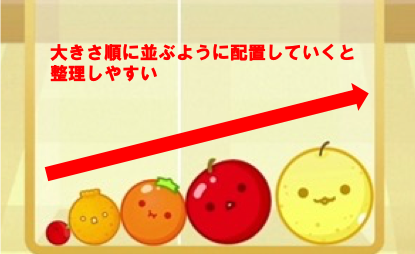
Keep in mind that the ‘evolutionary order’ can be verified using the ‘circle of evolution’ located on the right side of the screen. It displays the sequence, starting with ‘Persimmon,’ followed by ‘Apple,’ and then ‘Pear,’ and so forth. I also suggest playing while observing the images presented in a ‘side-by-side’ arrangement.
Visualizing the process of ‘evolution’ in your mind can enhance your gameplay experience as you continue to practice.
It is easy to have the image of ‘evolving’ in your mind, and play more and more times.

3. After the second tier: do not place large fruit on top of small fruit
Once you reach the second level, avoid stacking large fruits on top of smaller ones. Placing a large fruit over a small one and obstructing it makes it challenging for the fruit to evolve.
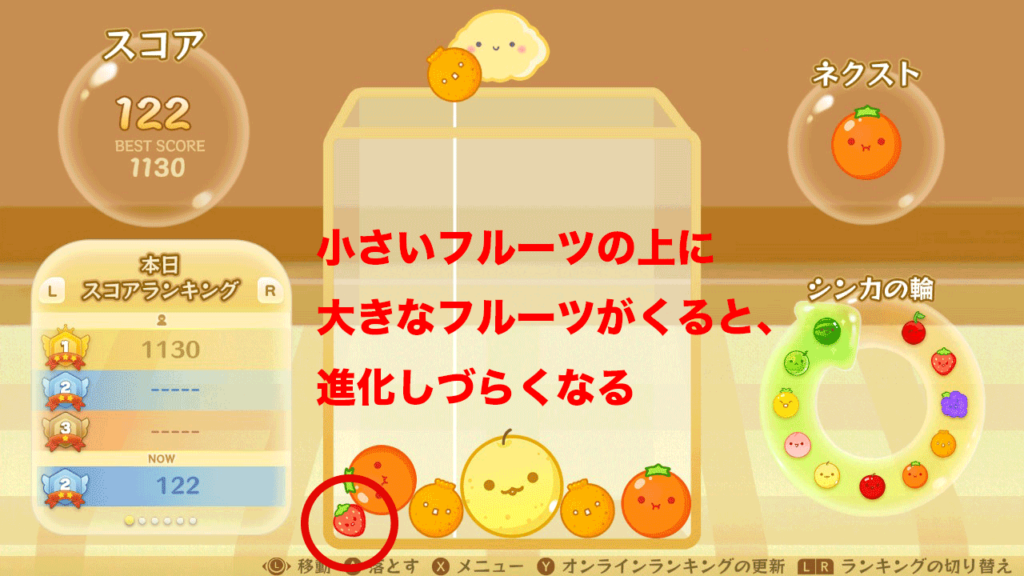
For instance, if you drop a ‘persimmon’ on top of a ‘strawberry’ as illustrated above, evolving the strawberry becomes challenging, doesn’t it? While it’s possible to adjust their evolution later, particularly with strategic planning, in the later stages of the game, smaller fruits tend to obstruct the movement of other fruits more frequently.
Therefore, exercise caution from the second level onward, ensuring not to stack large fruits on top of small ones.
4. Put small fruits on the ‘edge’
Furthermore, it’s not an issue if small fruits accumulate at the bottom of the fruit box. However, when they wedge in between fruits, they disrupt the evolution process and cause the fruits to grow taller.
Particularly troublesome are cases where small fruits, positioned in a way that hinders their movement, like ‘a strawberry between two peaches,’ obstruct the evolution of fruits in crucial positions, leading to a game over. Thus, it’s vital to be cautious if you don’t have an immediate plan for evolving them.
Small fruits that are challenging to manage should be strategically ‘placed on the edge’ rather than scattered randomly.
5. Don’t wait too long to finish moving
The fifth and final tip for creating watermelons in the watermelon game is to avoid waiting too long for the fruit to drop. One of the game’s attractions is the absence of a time limit. However, if you delay for the fruit to settle completely, you might miss the opportunity for evolution.
By initiating the next move while the previous fruit is still in motion, you can create a continuous flow and evolve fruits that have a larger gap between them. Therefore, it’s essential to discern when to wait for the fruit to finish moving entirely and when to drop the next fruit immediately.
Furthermore, if you find it challenging to make watermelons even after trying the aforementioned tips, we recommend watching gameplay videos of experienced players for valuable reference.
What is the strategy for over 3000 points?
For players of the ‘Suika game‘ (watermelon game), the next significant challenge after mastering watermelon creation is reaching ‘3000 points.’
To surpass the 3000-point mark, you typically require ‘1 watermelon + 1 melon (or 2 pineapples).*1
*1 While rare, alternative combinations are possible, such as ‘1 watermelon + 1 pineapple + 4 peaches.
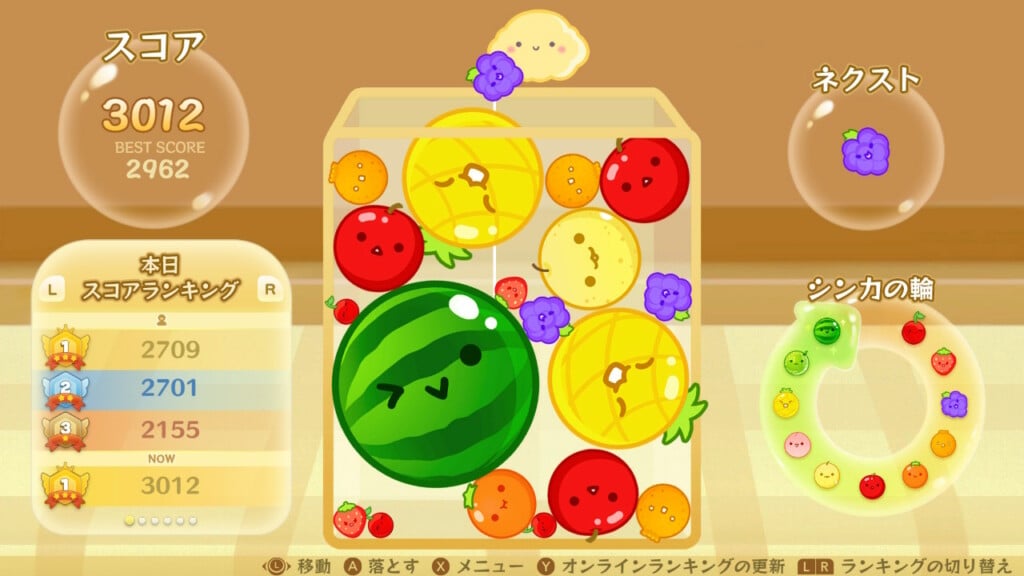
The image above illustrates the achievement of 3,000 points using ‘1 watermelon + 2 pineapples.’ As you can see, the game board is filled with large fruits, occupying significant space and increasing the risk of the game ending prematurely.
The next three tips will assist you in reaching 3,000 points or more in the watermelon game.
<The strategy for the 3000-point>
- Make the watermelon in an ‘out of the way’ position
- Make sure the slope is gentle, not steep
- Don’t make larger fruits ‘unnecessarily sparse’
1. Make the watermelon in an ‘out of the way’ position
In the ‘Suika game‘ (watermelon game), achieving a high score of 3000 points or more hinges greatly on the placement of the watermelon. As mentioned earlier, to reach a score of 3000 points, a large fruit combination (1 watermelon + 1 melon (or 2 pineapples)) must be strategically positioned within the box.
To ensure optimal use of space,
Watermelons should be anchored either at the ‘bottom right’ or ‘bottom left‘ corners of the box.
You might find it challenging to adjust the watermelon’s position, but by following the watermelon-making tips outlined in the previous section, specifically ‘2. early stage of the game: line up ‘horizontally’ with ‘evolutionary order’ in mind,’ and organizing fruits based on their size, it becomes easier to secure the watermelon at the right or left edge.
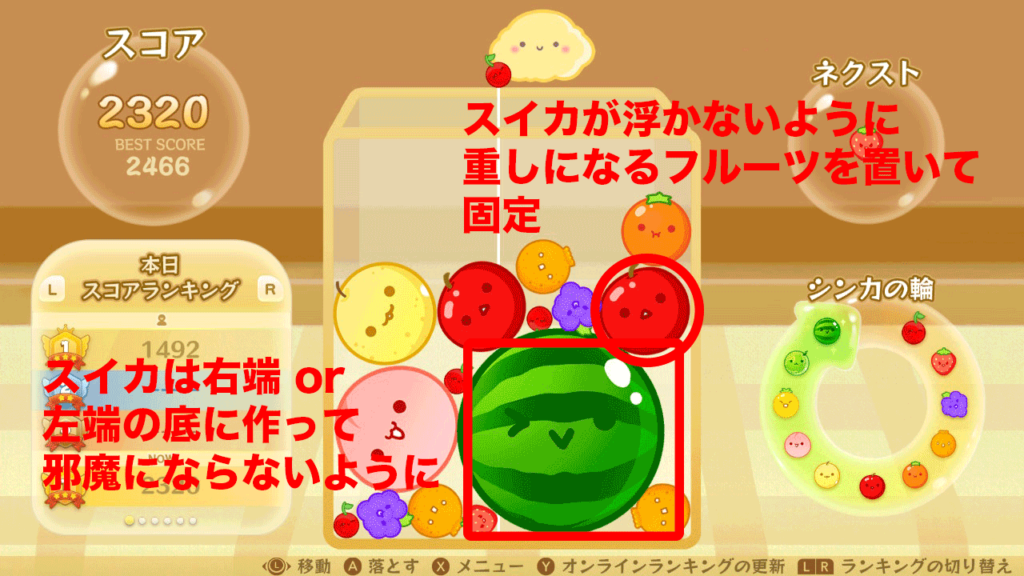
It is advisable to position another fruit on top of the watermelon to anchor it securely, preventing the watermelon from floating in the middle of the process.
2. Make sure the slope is gentle, not steep
To achieve a score higher than 3000 points, it’s crucial to prevent fruits from evolving in unexpected locations. If there is a ‘steep slope’ within the box, the available dropping spots for fruits become limited. Dropping a fruit in such a situation may lead to instability, causing it to roll to an unintended position and disrupt the evolution process of the desired fruit. This interference makes scoring over 3000 points challenging.
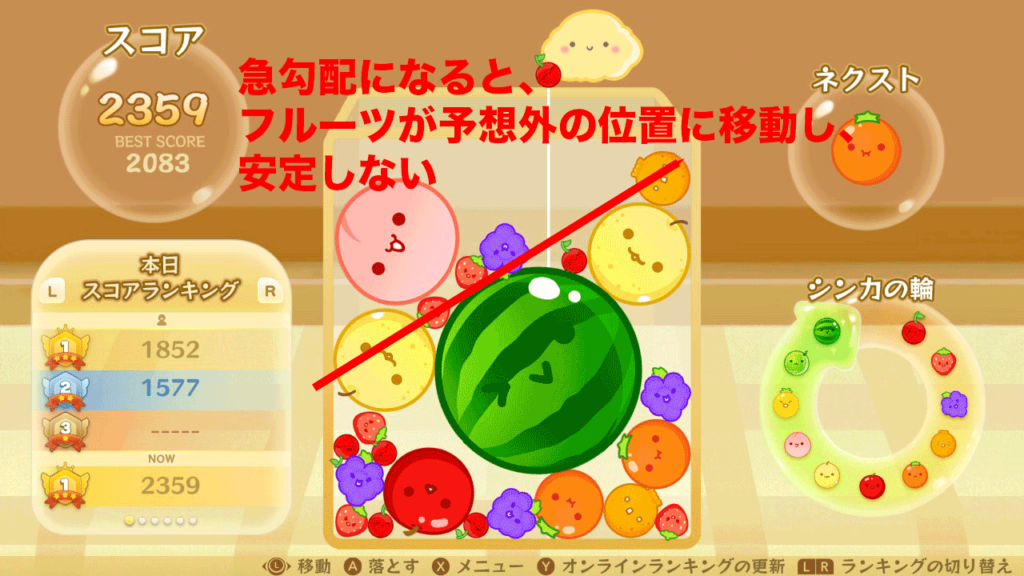
Whenever possible, the inside of the box should have a ‘gentle slope’ with a ‘horizontal expansion’ and ‘spread’ to create ample space for dropping and storing fruits.
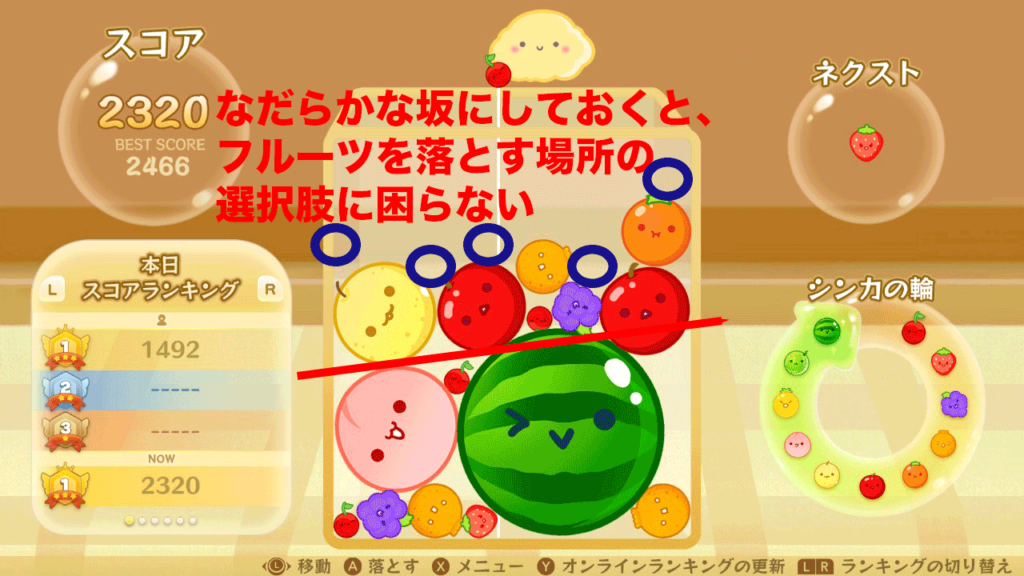
Strive to create a ‘gentle’ slope rather than a steep one.
3. Don’t make larger fruits ‘unnecessarily sparse’
The third and final strategy to achieve over 3,000 points in the watermelon game is to avoid wasting time by creating larger fruits sparsely. Once you exceed 3,000 points, randomly placing large fruits can quickly lead to space running out. If the next required fruit doesn’t appear in time, the game will swiftly come to an end.
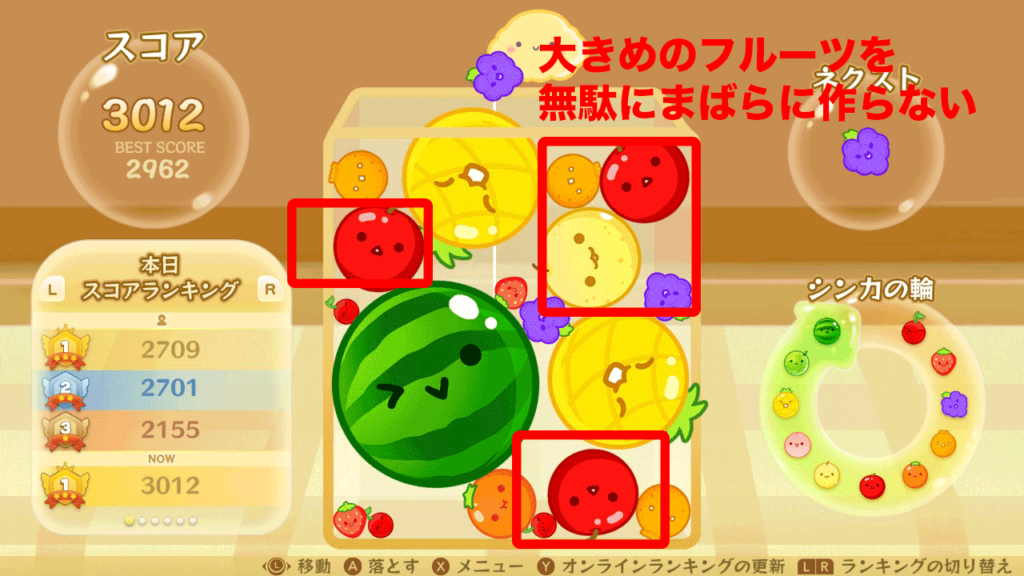
Be mindful of not excessively increasing the number of larger fruits, yet, simultaneously, avoid scattering them too sparsely.
Luck is also important in Suika Game! Let’s have fun by playing more times!
As you can see, ‘Suika game‘ (watermelon game) offers various strategies such as ‘tips on how to make watermelons’ and ‘tips on how to score more than 3000 points.’ If you find it challenging to create watermelons as desired or struggle to surpass 3000 points, experiment with the methods that best suit your style of play.
Despite the numerous tips and strategies, luck plays a crucial role in the watermelon game. The appearance of the next fruit can significantly impact your score, and unexpected moves can sometimes lead to miraculous outcomes. Luck is undeniably a factor.
To aim for a high score, you must anticipate moves in advance, deciding where to drop and evolve the fruit. In some situations, you may need to swiftly adjust your strategy, requiring experience and quick decision-making skills.
Ultimately, the key to mastering the watermelon game is to enjoy the process and have fun while playing it repeatedly.


